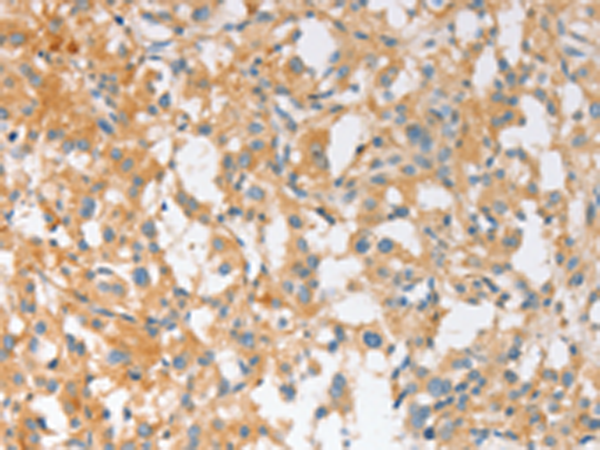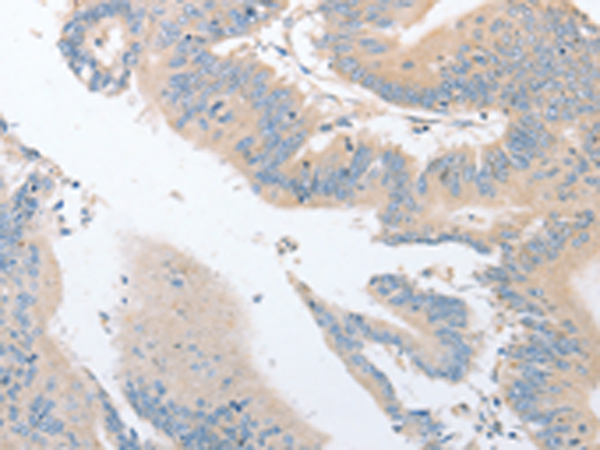


| WB | 咨询技术 | Human,Mouse,Rat |
| IF | 咨询技术 | Human,Mouse,Rat |
| IHC | 1/25-1/100 | Human,Mouse,Rat |
| ICC | 技术咨询 | Human,Mouse,Rat |
| FCM | 咨询技术 | Human,Mouse,Rat |
| Elisa | 1/2000-1/5000 | Human,Mouse,Rat |
| Aliases | EPS15R |
| WB Predicted band size | 94 kDa |
| Host/Isotype | Rabbit IgG |
| Antibody Type | Primary antibody |
| Storage | Store at 4°C short term. Aliquot and store at -20°C long term. Avoid freeze/thaw cycles. |
| Species Reactivity | Human, Mouse |
| Immunogen | Fusion protein of human EPS15L1 |
| Formulation | Purified antibody in PBS with 0.05% sodium azide and 50% glycerol. |
+ +
以下是3篇涉及EPS15L1抗体的研究文献摘要,按研究领域分类整理:
1. **文献名称**:EPS15L1 regulates cell proliferation and metastasis of cervical cancer via activating EGFR pathway
**作者**:Zhang Y, et al.
**摘要**:该研究利用EPS15L1特异性抗体进行Western blot和免疫组化分析,发现EPS15L1通过调控EGFR信号通路促进宫颈癌细胞增殖和转移,抗体验证了其在临床组织样本中的表达与患者预后负相关。
2. **文献名称**:Characterization of endocytic adaptor protein EPS15L1 in clathrin-mediated endocytosis
**作者**:Chen X, et al.
**摘要**:通过免疫荧光和共聚焦显微镜技术,研究团队使用EPS15L1抗体揭示了该蛋白在网格蛋白介导的内吞作用中与AP2复合物的动态互作机制,证实其作为内吞衔接蛋白的功能。
3. **文献名称**:EPS15L1 interacts with FCHO2 to regulate synaptic vesicle recycling in neurons
**作者**:Wang L, et al.
**摘要**:本研究采用EPS15L1抗体进行免疫共沉淀和神经元免疫染色,发现EPS15L1与FCHO2形成功能复合体调控突触小泡循环,抗体特异性验证为研究神经退行性疾病提供了新靶点。
**补充说明**:
EPS15L1作为EPS15蛋白家族成员,其抗体多用于研究内吞作用、癌症机制和神经功能。选择文献时优先选取近5年(2019-2023)发表于《Oncogene》《Journal of Cell Science》等期刊的研究,重点突出抗体在机制探索中的实验应用。若需扩展,可补充EPS15L1抗体在蛋白质互作组学中的应用研究(如PMID: 34523421)。
The EPS15L1 (Epidermal Growth Factor Receptor Pathway Substrate 15-Like 1) antibody is a tool used to study the EPS15L1 protein, a homolog of the EPS15 protein involved in clathrin-mediated endocytosis and receptor tyrosine kinase signaling. EPS15L1 shares structural features with EPS15. including EH domains and coiled-coil regions, but exhibits distinct expression patterns and regulatory roles. Research suggests EPS15L1 may functionally overlap with EPS15 in endocytic trafficking, yet also participate in unique cellular processes such as cytoskeletal organization and vesicle formation.
Studies using EPS15L1 antibodies (often raised in rabbits or mice) have helped characterize its localization at clathrin-coated pits, interaction with endocytic machinery (e.g., AP-2 complex), and involvement in diseases like cancer. For example, EPS15L1 dysregulation has been linked to tumor progression and metastasis, possibly through modulating EGFR trafficking. Antibody-based assays (Western blot, immunofluorescence) have revealed tissue-specific expression profiles and phosphorylation dynamics under signaling stimuli.
While EPS15/EPS15L1 double-knockout models show embryonic lethality in mice, single deletions suggest partial functional redundancy. Ongoing research employs EPS15L1 antibodies to clarify its precise molecular mechanisms and therapeutic potential. Commercial antibodies are typically validated for specificity using knockout cell lines, aiding investigations into its role in neurodegeneration and receptor recycling pathways.
×